Standardized Field Sobriety Tests
Upon starting to drive, or upon having physical possession of a car, you have subjected yourself to the possibility of being the subject of an investigation for DUI/DWI. A DWI conviction can have an adverse effect on your life and livelihood. If you are the subject of an investigation for intoxication, the police will request that you perform a number of standardized field sobriety tests. If you are stopped by police who request that you take a field sobriety test, then you are legally obligated to take the test as refusal may lead to immediate license suspension.
- Home
- /
- Our Services
- /
- New York Criminal Defense...
- /
- New York DUI/DWI Lawyer
- /
- The New York DUI...
The New York DUI Field Sobriety Tests
Have You Been Arrested for a DUI / DWI in New York? Talk to a Lawyer Now.
In 2019, there were over 34,000 DUI or DWI arrests in New York. This figure represents a decline in the number of such arrests in the state. In fact, 2019 marked the fifth consecutive year in which there was a reduction in the number of DUI arrests.
Additionally, 56,892 drivers were cited for impaired driving, with over 91.9 percent of citations going to drivers under the influence of alcohol and the other 8.1 being given to drivers under the influence of drugs.
A strong majority — over 73 percent — of drivers arrested for DUI or DWI are male, and people between the ages of 21-29 are most likely to be arrested.
Standardized Field Sobriety Tests (SFSTs) Used in New York
If you are stopped by police, who request that you take a field sobriety test, then you are legally obligated to take the test as refusal may lead to immediate license suspension. If you face arrest after carrying out the test, you should refuse to take any other tests that are requested of you, including breath, blood or urine. Although a jury may view your refusal as suspicious, if you complied with the New York Field Sobriety Tests, your DWI attorney can demonstrate to the jurors that you were cooperative with police, and were then arrested, as a result of which you refused to submit to a breath test.

Services
Contact
Contact us today for a free consultation. We are available 24 hours a day, 7 days a week, and 365 days a year.
The Field Sobriety Exercises
DUI/DWI police officers who are trained to investigate DUIs learn how to conduct five field sobriety tests. They are the Walk-and-Turn, HGN, One-leg Stand, Rhomberg Balance and Finger-to-Nose.
Developed by the National Highway Traffic Safety Association
These exercises, which were developed by the National Highway Traffic Safety Association (NHTSA), call for one to split attention, perform several tasks simultaneously, use the ability to remember and perform unusual physical tasks.
Police officers spend several hours in training on ways in which to administer the tests, and are given sufficient time in which to practice them. They are given a cheat sheet that is one page in length that contains diagrams and information to help them remember what to look for when you are completing the tests. However, police officers will not show you that cheat sheet to enable you to view beforehand what they are looking for in your performance of the tests.

The Exercises
Standard Field Sobriety Tests
The Walk and Turn
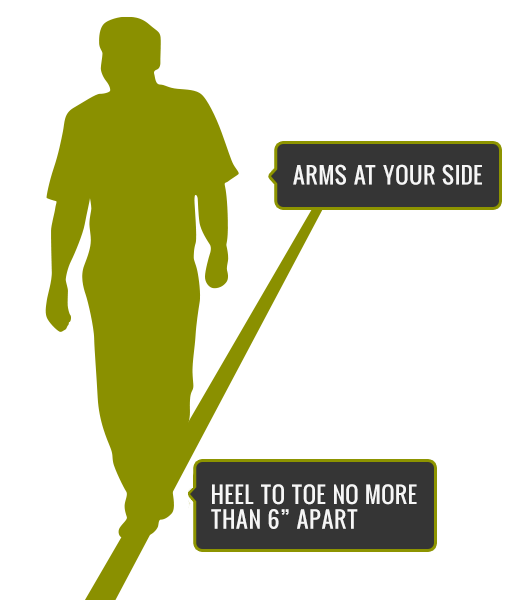
The police officer will initially ask you to stand in the starting position, with one foot before the other, with contact between heel and toe, and with your hands at your sides. You will have to stay in this position without loss of balance or any deviation from that position. If you return your front foot to a natural standing position, the officer can count that against you, contending that you were unable to keep your balance or take heed of directions.
The officer will then request that you walk in a straight line, putting one foot before the other, making contact between heel and toe. Do not lift your arms for balance. Do not step outside the line or create a gap that is more than six inches between your heel and toe. Following your ninth step, you will have to turn in a certain way. They will request that you take a number of small pivot steps while planting one foot down as the pivot point. You will then have to walk nine steps back to the point at which you started.
If you step outside the line, correct yourself right away and continue. While the majority of DUI officers will allow you to restart the test, they may later tell the jury that you needed to attempt to take the test two or three times.
Horizontal Gaze Nystagmus (HGN)
The HGN test is one where officers ask individuals to use their eyes to follow an object.
The officers look for three indications that could exist in each of your eyes:
1. whether your eye has nystagmus, or a jerking motion;
2. when the nystagmus initially happens;
3. whether you have noticeable nystagmus at “maximum deviation”
Before the HGN test, the officer is required to ask you a number of questions. They wish to make certain that you do not wear corrective lenses; are not afflicted with head trauma; or are not taking certain medications. Therefore, if you have nystagmus, they will argue that it is associated with impairment by alcohol.
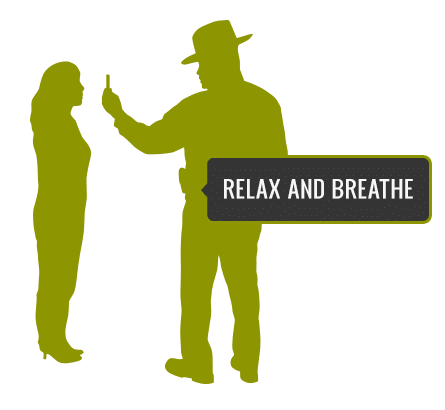
The One Leg Stand
The one leg stand is similar to the walk and turn test in that it has an instructional and performance aspect.
One Leg Stand: Listen Carefully
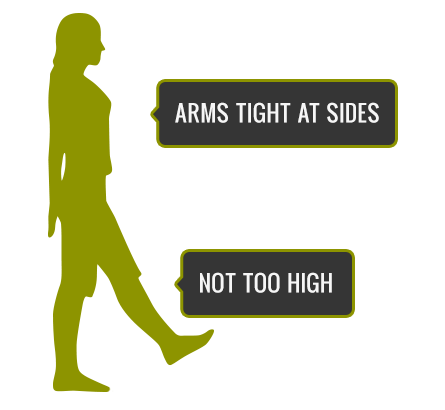
In the instructional part, you will be directed to stand on one leg while lifting the other leg in the air a minimum of six inches above the ground. Additionally, you will be asked to flex your foot, look down at the toes on that foot and keep your hands by your side. There may be times when you have to do this while counting out loud for approximately 30 seconds or until the officer instructs you to stop.
If you begin to hop on your foot in order to maintain your balance, it will not count in your favor. It is best to stay composed and relaxed. Attempt not to lift your leg to such a height that it produces a greater risk that you will lose your balance.
If you have an issue with a leg, knee, foot, ankle, back or any other medical problem that you believe could adversely affect your capacity to perform the test, inform the officer prior to starting the test. This should be part of the official record.
Finger to Nose
The final test that an officer usually administers is the finger-to-nose. The officer will request that you close your eyes, extend your hands out at your side, and when verbally ordered with “left” or “right,” use your index finger to make contact with the tip of your nose prior to returning it to your side.
Finger to Nose: Tips
Important points to keep in mind if you are asked to take this test:
1. Keep your eyes closed for the duration of this test.
2. Use the “tip” of your index finger to touch the “tip” of your nose.
Usually, people place the pad of their index finger on the tip of their nose. However, this will count against you. If you touch any part of your nose aside from the tip of it, that will also count against you. Furthermore, do not attempt to guess which hand the officer wishes you to use. They will tell you.
It is important that you remain calm and listen carefully. Police may not always alternate uniformly. They may try to trick you and say “left-right-right-left.” Always remove your finger after making contact with your nose, and return it to your side.
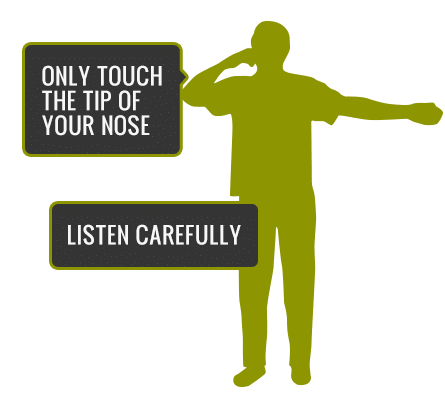
Rhomberg Balance
The Rhomberg balance is another test that measures your balance and capacity to remember directions.
Rhomberg balance: Be Ready to Multi-task
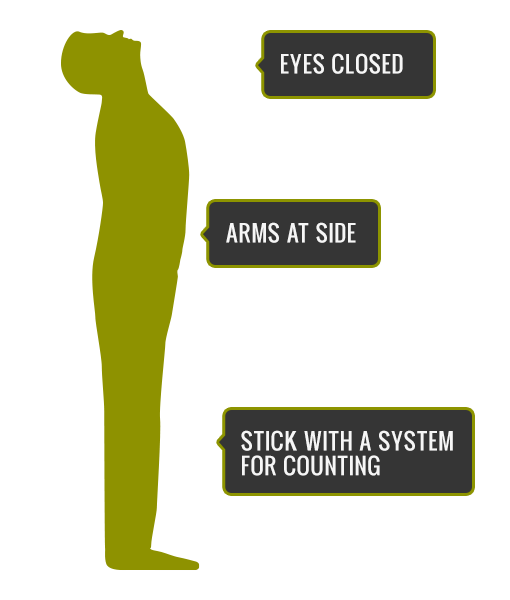
The Rhomberg balance is another test that measures your balance and capacity to remember directions. In addition, it requires you to multi-task. During the instructional segment, the officer will request that you stand with your feet together, and put your hands down at your side. When you are instructed to start, tilt your head back, close your eyes, guess when 30 seconds have passed, return your head forward, open your eyes, and say stop.
The officer will be looking for any signs of hopping, swaying or loss of balance. Additionally, the officer will notice if you do not keep your eyes closed, you count aloud, and not in your head, or if you spend an inordinate amount of time counting. Generally, alcohol causes people to have delayed reactions.
The officer will be keeping time with the use of a digital stopwatch. If you do not stop until after 60 – 90 seconds have elapsed, they will attempt to use that against you. It is recommended that you have a method of counting and stick with it. Do not be alarmed if you are not directed to perform this test because it is not administered every time.